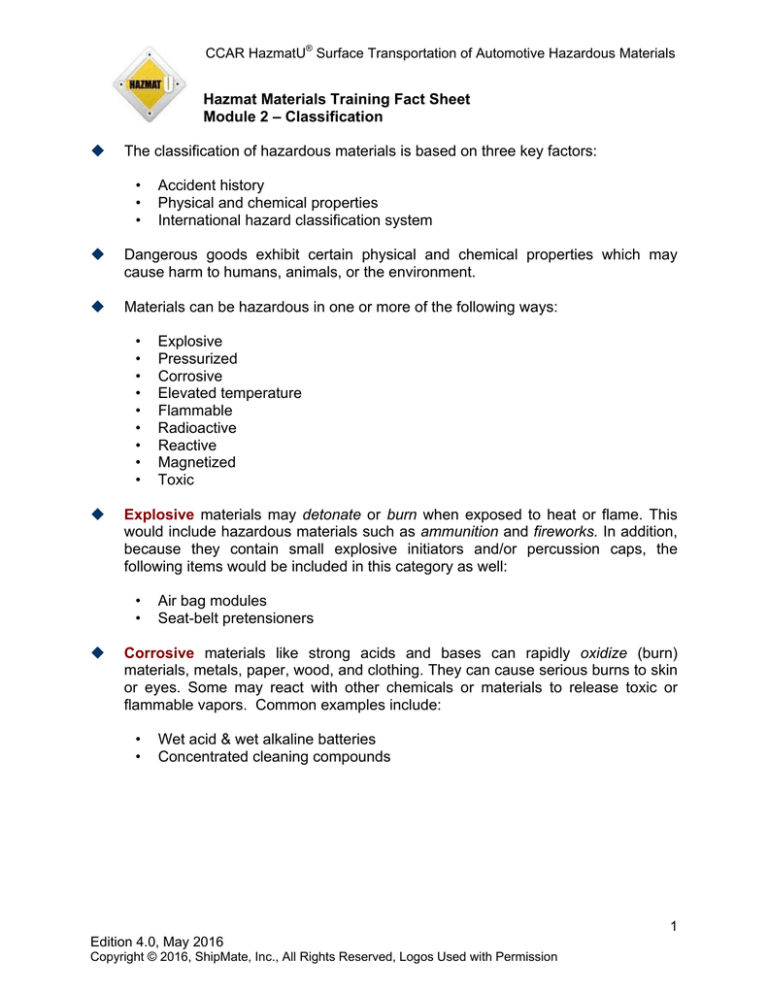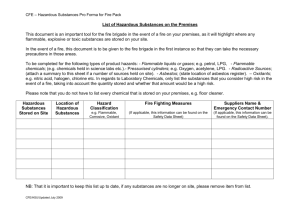
CCAR HazmatU® Surface Transportation of Automotive Hazardous Materials
Hazmat Materials Training Fact Sheet
Module 2 – Classification
The classification of hazardous materials is based on three key factors:
•
•
•
Accident history
Physical and chemical properties
International hazard classification system
Dangerous goods exhibit certain physical and chemical properties which may
cause harm to humans, animals, or the environment.
Materials can be hazardous in one or more of the following ways:
•
•
•
•
•
•
•
•
•
Explosive materials may detonate or burn when exposed to heat or flame. This
would include hazardous materials such as ammunition and fireworks. In addition,
because they contain small explosive initiators and/or percussion caps, the
following items would be included in this category as well:
•
•
Explosive
Pressurized
Corrosive
Elevated temperature
Flammable
Radioactive
Reactive
Magnetized
Toxic
Air bag modules
Seat-belt pretensioners
Corrosive materials like strong acids and bases can rapidly oxidize (burn)
materials, metals, paper, wood, and clothing. They can cause serious burns to skin
or eyes. Some may react with other chemicals or materials to release toxic or
flammable vapors. Common examples include:
•
•
Wet acid & wet alkaline batteries
Concentrated cleaning compounds
1
Edition 4.0, May 2016
Copyright © 2016, ShipMate, Inc., All Rights Reserved, Logos Used with Permission
CCAR HazmatU® Surface Transportation of Automotive Hazardous Materials
Materials considered flammable include gases, liquids, and solids that can ignite
quickly, burn rapidly, and give off intense heat. Common flammables include:
•
•
•
•
•
•
Flammable materials are substances that, when transported under forced heating,
at or above their flashpoint, or substances transported at elevated temperatures
(e.g., molten), can cause other combustible materials to ignite through conduction
(in contact with) or convection (radiation of heat). Common examples include:
•
•
•
Molten sulfur
Molten aluminum
Bituminous asphalt
Reactive materials are those substances that may chemically mix with air, water,
or other substances to cause exothermic (liberate heat) reactions. Many produce
oxygen and will burn quickly. In addition, many do not have to be near heat or
flames to ignite – they can burn spontaneously. Many also generate toxic and
flammable vapors as well. Common reactive materials include:
•
•
•
Acetylene & propane
Absorbent contaminated with fuel
Gasoline & fuel additives
Paint & paint thinners
Solvents & cleaning compounds
Adhesives & coating solutions
Benzoyl Peroxide (e.g., epoxy cream hardener)
Hypochlorite solutions (e.g., bleach)
Cleaning compounds
Radioactive materials are substances undergoing rapid electrical and subatomic
transformations, thus exhibiting radioactivity (a spontaneous discharge of energy).
This energy may cause our cells to become genetically altered. Radioactive
materials can include:
•
•
X-ray equipment
Smoke detectors
2
Edition 4.0, May 2016
Copyright © 2016, ShipMate, Inc., All Rights Reserved, Logos Used with Permission
CCAR HazmatU® Surface Transportation of Automotive Hazardous Materials
Toxic materials are substances that, if allowed to enter the body through the nose,
mouth, or skin, can make you sick – or even cause death. Fumes, dust, and
vapors from toxic materials can be especially harmful because they can be inhaled
and pass quickly through the lungs into the blood, allowing the poisons to circulate
throughout the body. Common toxic materials include:
•
•
•
Pressurized materials that are contained under extreme pressure are particularly
dangerous because the energy is stored within a confined volume which could be
released instantly if the cylinder or fittings fail or rupture. In some cases, the
gaseous materials may also be extremely cold because they are cryogenic
(refrigerated) gases. Common examples include:
•
•
•
•
•
•
•
Pesticides
Chlorinated solvents (e.g., parts wash solution)
Fumigants
Accumulators (e.g., shocks, struts)
Acetylene & argon
Fire extinguishers
Refrigerants
Tire inflators
Certain air bag modules (e.g., air curtains)
Aerosols
Magnetized materials are regulated for air transport when shipped in large
quantities only because the magnetic field induced by the articles may affect the
aircraft's navigational instruments. Therefore, magnetized materials are required to
be stowed on aircraft in specially designed compartments, or fitted with Faraday
shielding, to reduce the magnetic interference. Common magnetized material
include:
•
•
•
Speakers
Magnetic clutches
Magnetic switches
3
Edition 4.0, May 2016
Copyright © 2016, ShipMate, Inc., All Rights Reserved, Logos Used with Permission
CCAR HazmatU® Surface Transportation of Automotive Hazardous Materials
International standards have been established by the UN Committee of Experts on
the Transport of Dangerous Goods. They have assigned hazardous materials into
one of nine internationally recognized and adopted hazard classes, including:
•
•
•
•
•
•
•
•
•
Class 1 hazardous materials are explosive substances. There are six divisions of
explosives, including:
•
•
•
•
•
•
Class 1 - explosives
Class 2 - gases
Class 3 - flammable liquids
Class 4 - flammable solids & pyrophoric liquids
Class 5 - oxidizers & organic peroxides
Class 6 - toxic materials
Class 7 - radioactive materials
Class 8 - corrosive materials
Class 9 - miscellaneous dangerous goods, substances, & articles
Division 1.1 - mass explosion (e.g. TNT, dynamite)
Division 1.2 - projection hazard (e.g., missiles, grenades)
Division 1.3 - fire hazard (e.g., flares, fireworks)
Division 1.4 - no significant blast (e.g., air bags, small arms cartridges)
Division 1.5 - very insensitive (e.g., blasting agents, ammonium nitrate)
Division 1.6 - extremely insensitive (e.g., squibs)
Class 2 is comprised of compressed, liquefied, and cryogenic (refrigerated) gases
and gases in solution. This class also includes articles containing substances of
Class 2 such as shock absorbers, brake boosters, and hood stays. There are three
divisions of Class 2 gases:
•
•
•
Class 2.1 - flammable gases (e.g., propane, acetylene)
Class 2.2 - non-flammable gases (e.g., fire extinguishers, refrigerants)
Class 2.3 - toxic gases (e.g., fumigants, carbon monoxide)
4
Edition 4.0, May 2016
Copyright © 2016, ShipMate, Inc., All Rights Reserved, Logos Used with Permission
CCAR HazmatU® Surface Transportation of Automotive Hazardous Materials
Class 3 substances are comprised of:
•
•
Flammable liquids
Liquid desensitized explosives
Flammable liquids are further defined as liquids, mixtures of liquids, or liquids
containing solids in solution or suspension (e.g., paints, lacquers) that emit
flammable vapors and which have a flashpoint (temperature at which the vapor-air
mixture can ignite) of ≤ 60 °C (140 °F), as determined by a closed-cup flammability
testing apparatus. Common flammable liquids include gasoline, fuel additives,
paint, adhesives, coating solutions, solvents, and alcohols.
Class 4 includes substances and articles, other than those classified as
explosives, which are readily combustible, self-reactive, or which may cause or
contribute to a fire. Class 4 is divided into three divisions:
•
•
•
Class 4.1 - flammable solids
Class 4.2 - substances liable to spontaneous combustion
Class 4.3 - substances that, in contact with water, emit flammable or toxic gas
Class 5 is divided into two divisions:
•
•
Class 5.1 - oxidizing substances
Class 5.2 - organic peroxides
Class 5.1 oxidizers are substances that may yield oxygen which causes, or may
contribute to, the combustion of the substance or other materials. A common
example of an oxidizer is 8 percent or greater concentrations of hydrogen
peroxide.
Class 5.2 organic peroxides are derivatives of hydrogen peroxide with a special
chemical structure which may be thermally and chemically unstable. Class 5.2
substances may undergo an exothermic, self-accelerating decomposition to the
point where they can suddenly explode. In addition, they may have one or more of
the following properties:
•
•
•
•
Liable to explosive decomposition
Burn rapidly
Sensitive to impact or friction
React dangerously with other substances
5
Edition 4.0, May 2016
Copyright © 2016, ShipMate, Inc., All Rights Reserved, Logos Used with Permission
CCAR HazmatU® Surface Transportation of Automotive Hazardous Materials
Class 6 hazardous materials have two divisions:
•
•
Class 6.1 - toxic materials
Class 6.2 - infectious substances
Class 6.1 toxic materials are solid or liquid substances that may cause death or
serious illness, or which may be harmful to humans or animals, if swallowed,
inhaled, or absorbed through the skin. Common examples include: pesticides,
arsenic, and common chlorinated degreasing solvents such as 1-1-1trichloroethylene and dichloromethane.
Class 6.2 infectious substances are those substances which are known to, or
which can be reasonably expected to, contain pathogens. Pathogens are defined
as micro-organisms, which may cause infectious disease in animals or humans.
Class 6.2 infectious substances may include:
•
•
•
Class 7 radioactive substances and articles contain radionuclides (radioactive
particles) that are electrically charged and which can emit one or more different
types of radiation. Although there are not divisions within Class 7, there are four
different radioactive labels that correspond to the radioactivity of the substance or
article. Common examples of radioactive material include:
•
•
•
•
Anthrax
Hepatitis C
E. coli
Smoke detectors
Radiography equipment
Fissile materials
Radioactive soils
Class 8 hazardous materials are a corrosive substance that may cause necrosis
(death of living tissue) or which will corrode aluminum or steel more than 6.25 mm
(1/4 inch) per year. Corrosives may be acidic (have a low pH) or alkaline (have a
high pH). The pHscale is a measure of the concentration and type of chemically
reactive particles in a solution. Common corrosive hazardous materials include:
•
•
•
Battery electrolyte
Window etch kits
Cleaning compounds
6
Edition 4.0, May 2016
Copyright © 2016, ShipMate, Inc., All Rights Reserved, Logos Used with Permission
CCAR HazmatU® Surface Transportation of Automotive Hazardous Materials
Class 9 miscellaneous dangerous substances and articles are those which do not
meet the definition of the other eight hazard classes but which, based on human
experience, pose a threat to health, safety, property, or the environment. This class
may include marine pollutants (e.g., aldrin) which are harmful to the aquatic
environment. Common automotive examples include:
•
•
•
•
•
Air bag modules (reclassed from Division 1.4) *
Used engines (containing fuel residues)
Used fuel system components
Vehicles
Seat-belt pretensioners (reclassed from Division 1.4) *
* collectively referred to as Safety Devices
7
Edition 4.0, May 2016
Copyright © 2016, ShipMate, Inc., All Rights Reserved, Logos Used with Permission




